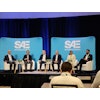
responses submitted by Dennis Slater, President, Association of Equipment Manufacturers (AEM)
Government & Trade
How, if at all, has the current state of the global trade tensions—particularly those between the U.S. and other countries—had an impact on the industry?
Pro-growth trade policies keep the U.S. equipment manufacturing industry strong and our 1.3 million workers employed. That’s why we consistently advocate in Washington for policies helping our industry compete in an increasingly tough global market and export more U.S. manufactured goods across the globe.
We agree with the Trump administration concerns regarding China’s unfair trade practices, including weak intellectual property protections, restrictions on U.S. investment, and policies that limit fair competition.
However, we don’t believe the use of tariffs is the right way to fix China’s unfair trade practices and will not bring about long-term, structural reforms needed to address China’s trade and industrial policies. Instead, we should work with our trading partners also negatively impacted by China’s trade practices and consider other tools such as restricting Chinese investment in the U.S. as a way to pressure the Chinese government to change course.
Read more: AEM Joins Tariff Reform Coalition
Do you foresee the passage of the United States-Mexico-Canada Agreement (USMCA) being a benefit to overcoming the trade tensions, or just being a benefit in general?
Ratifying the USMCA will help create jobs, secure access to our two largest export markets, and help ensure North America’s manufacturing competitiveness. USMCA will also provide better market access for U.S. farmers at a time when America’s rural economies are suffering due to China’s counter tariffs on U.S. agricultural exports. If you support U.S. manufacturing, tell Congress to ratify the agreement now.
Are there other policies you are keeping your eye on that could impact (or have already impacted) the industry, for the better or worse?
The U.S. Export-Import Bank is a critical tool for AEM member companies. The bank assists U.S. manufacturers in securing export credit and insurance which allows more American made goods to be exported into many of the world’s emerging markets.
Recently, the bank had been hampered by a lack of quorum on the board preventing the bank from being fully functional. With the quorum finally being restored, AEM is now at the forefront of fighting to ensure that the U.S. Export-Import Bank obtains a multi-year reauthorization by the end of September when the bank’s current charter is set to expire.
Reauthorizing the bank is vitally important to U.S. equipment manufacturers of all sizes seeking to increase their exports, compete in the global market and hire more American workers.
Diesel, Electric and Other Power Alternatives
How, if at all, do you see alternative fuels fitting into the heavy equipment industry? Are there other power sources beyond diesel or electric you see coming into the industry?
Power sources are driven by return on investment, so diesel fuel is ingrained into our machines; it is reliable, less costly and readily available through our current infrastructure. Plus, with Tier 4 engines in most of our products, we have a power source that is very environmentally friendly with minimal amounts of NOx or particulates released into the atmosphere.
Our industry segments may see more increases in the use of alternative fuels such as natural gas, propane, fuel cell, diesel hybrid, battery electric and biofuel energy that is huge in the agriculture industry. Engines burning conventional petrochemical diesel fuel are being driven out of the industries by emissions legislation.
Technological advances and customer demands will help determine the fuel sources of the future based on being resourceful, economical, environmentally friendly and fulfilling the need and demands of equipment customers. There are plenty of alternative fuel resources out there, but it comes down to clean air and investment costs.
Data, IoT & Connectivity
What benefits is the Internet of Things (IoT) bringing to the industry as a whole, and how do you see it continuing to be beneficial in the coming years?
IoT and the connectivity of sensors is crucial for our industry to move beyond telematics being delivered daily. It could drive production data live while the machines are operating. It can drive safety on the jobsite with proximities, the same way autonomous cars are being tested. It will also drive efficiency with fuel burn, and reduction of costs through smart planning.
Are you seeing any new opportunities in regards to connectivity, and if so, what technologies are making these possible?
Connectivity is everything. Technology using 4G LTE is good enough for most simple monitoring as live data is not critical. Remote operating could bring a new level of workforce recruitment to those in wheelchairs. Not having to be ON the jobsite could open doors.
The data sharing and increasing ability to connect multiple pieces of equipment and tools on the jobsite will make operating more efficient as well as the ability for multiple stakeholders/roles at the contractor level to work collaboratively. This especially comes into play with getting digital plans from one contractor’s system to the sub-contractor in a format they can use.
Challenges & Opportunities
Are there any technologies or trends which you are currently excited about in the heavy-duty vehicle industry, or most looking forward to seeing in the coming years?
The biggest challenge to overcome is different OEM systems’ connectivity to each other. Interoperability is the most exciting short-term challenge and opportunity - along with the increasing ability to pull in large amounts of data and, using artificial intelligence, making sense of that, developing algorithms for predictive maintenance or analytics.
Are there trends you’re seeing in other industries which you think could have an impact on the heavy vehicle market in the near future?
Adoption, adoption adoption - volume of demand will make this industry move faster. The consumer market has really become a pull as people are adopting things like voice control (think devices such as Amazon Echo) and connected home devices. This drives competition and plummets the costs of components, which will help them move into the off-highway market faster.
We’ve made a concerted effort for our upcoming CONEXPO-CON/AGG 2020 exhibition to serve as a forum for seeing new trends and innovations, in the exhibits, in the education, and in our Tech Experience.
In 2017, we introduced the show’s Tech Experience as an area devoted solely to presenting new construction innovations and emerging technologies that will drive change and improvement across the construction industry. In 2020 we will continue, with a focus on modern mobility, sustainable building, and smart cities.




















